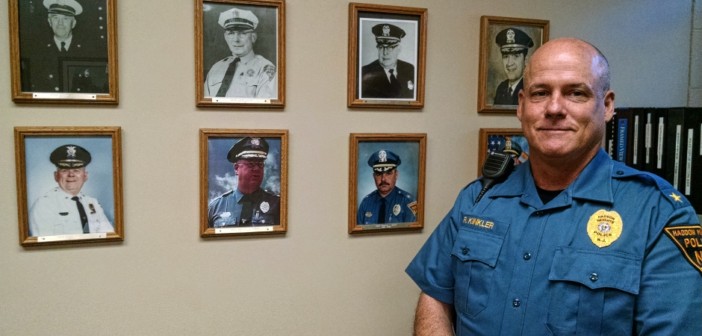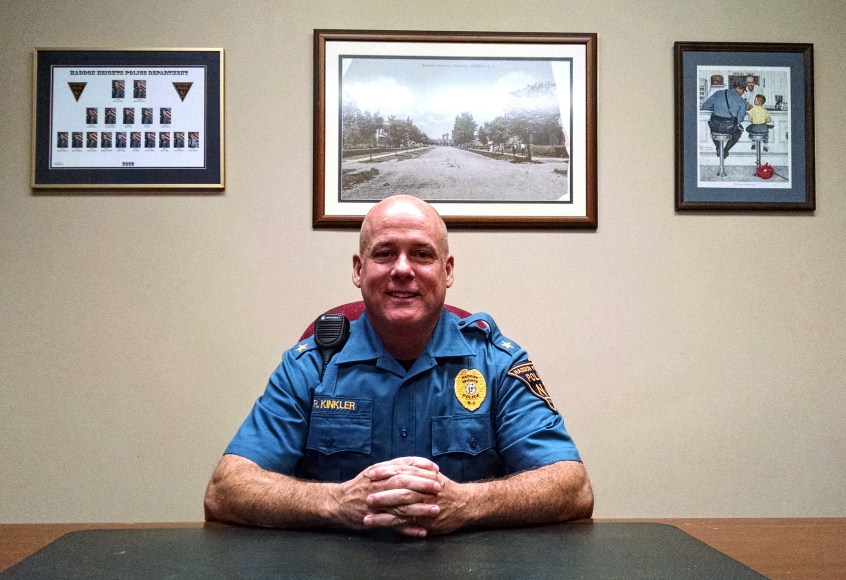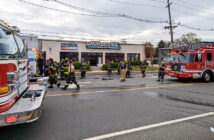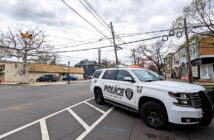A lifelong Haddon Heights resident, Richard Kinkler reflects on his years of service in the borough in which he was raised.
By Matt Skoufalos | August 15, 2016
Haddon Heights Police Chief Richard Kinkler has never had a job he didn’t like.
Whether it was his first gig as a custodian at Haddon Heights High School, the 21 years he spent in the armed forces, or his 25 years in the borough police department, Kinkler has loved them all.
A hometown boy through and through, he reflects on the symmetry of a working life in the borough that “started on Second Avenue and ended up on Seventh.”
Now, as the chief prepares to retire from the department of which he has been a fixture since 1993, Kinkler looks back on his time spent in service—to his country, to his community, and to the men and women alongside which he’s worked to keep it all safe.
Kinkler spent 21 years in the armed forces, including four in the Marine Corps, and six as an avionics technician in the Army National Guard before he completed Officer Candidate School and became an Armor Officer. Driving an M1 tank and commanding a platoon of soldiers was “the world’s best job,” Kinkler said, but while in the National Guard, the self-described workaholic also attended college full-time and worked for Audubon Plumbing Supply while looking for a police job. In January 1993, he was hired as a patrolman in Haddon Heights, and within 14 years, had risen to the rank of chief.
In that time, Kinkler served under four previous chiefs—Ronald Shute, Ted Taylor, Donald Wilson, and John Spiegel—men whom he said influenced his leadership style and helped shape his understanding of the job.
“Any good leader would always tell you you have to have a bone-deep concern for your officers or your soldiers,” Kinkler said. “It’s not that you lead by example, but that you led by example. [People] are going to judge you on what you did.”
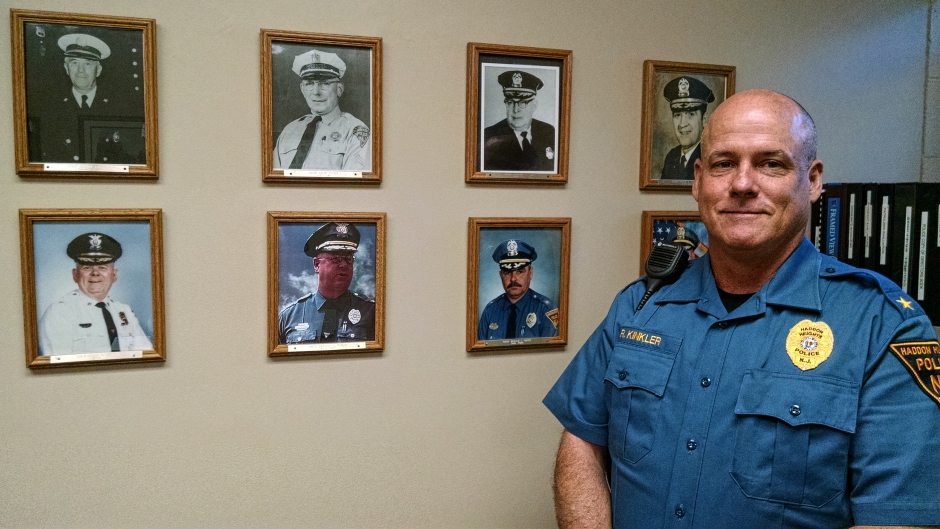
Haddon Heights Police Chief Rich Kinkler stands with his predecessors in the department. Credit: Matt Skoufalos.
‘The right thing to do’
Kinkler believes a police chief must possess the ability to connect with a variety of people, from elected officials to officers in the department to the general public, and to be responsive to their needs.
Although the decision has yet to be finalized by the borough council, Kinkler has already nominated his replacement.
The interview process was extensive, and in the end, the chief feels confident that his selection will leave the community and the department in good hands.
“The hardest part is that you have to select somebody, but it’s for the right reasons,” he said. “I’m pretty happy with all of my guys. If I knew I needed something done, support for an issue, or an honest opinion, these guys would tell me when I was wrong, and I appreciate that.
“I’m a very demanding guy in general, and as certain guys really stepped up to the plate for me, they deserve their time in the spotlight,” he said.
Even after 25 years, Kinkler said he would prefer to stay in the job, but that leaving is “just the right thing to do.
“I get five guys who get to be happy,” he said: “a chief, a captain, a sergeant, a patrolman, and I get to hire a Special Law Enforcement Officer. And I get to be cheaper next year than I was this year.”
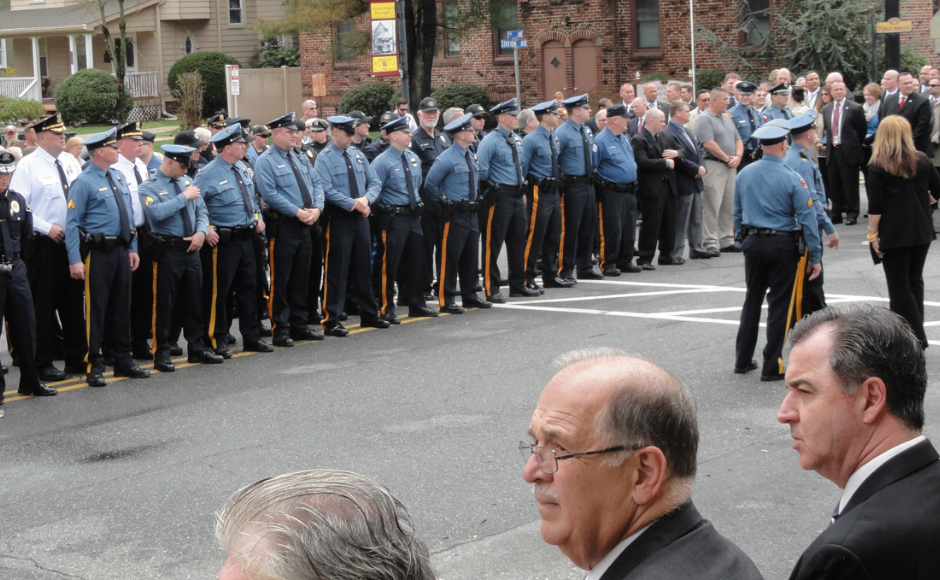
Police line the streets of Haddon Heights in a memorial for fallen officers John Norcross and James McLaughlin. Credit: Matt Skoufalos.
Knowing the community
Although Haddon Heights has no imminent interest in joining a consolidated county police force—Councilman Rick DiRenzo famously pulled the borough out of such negotiations with the multi-community Colonial Alliance some years back when talk of police mergers was on the table—Kinkler knows his successor will face budget pressure, and the question may arise again.
He still believes the local policing model offers the best “bang for the buck” in a community that has one of the lowest crime rates in the area.
“Compared to crime rates and dollars per resident, the local police model is one of the cheapest around,” the chief said. “Guys do a great job with being proactive police officers. If you were to ever go to a larger police model, you’re not as in touch.”
Knowing the community inside and out is vital to doing the job well, Kinkler said; as a longtime resident and member of the borough planning board, when there’s an emergency, he has a connection to its location from the outset.
“I can picture your house,” he said. “Chances are I know one of your neighbors.
“There’s been times in my career that I’ll hear in the wind there’s some issue in town,” Kinkler said. “I’ll call parents up and say, ‘What’s going on?’ I’m not there to get an admission from them; I’m there to put it on the radar for them. They’re my neighbors; I live with them.”
Keeping the community foremost in policing efforts is among the greatest demands of the job, and Kinkler believes he’s done a lot of work to advance that goal, particularly in building positive relationships with kids in the community and in enforcing traffic violations around its neighborhood schools. The 15-person department is too small to have a specialized unit for juvenile relations, so everyone is expected to be an ambassador for his or her colleagues, whether in the adopt-a-cop literacy program, appearances at community events, or one-on-one encounters.
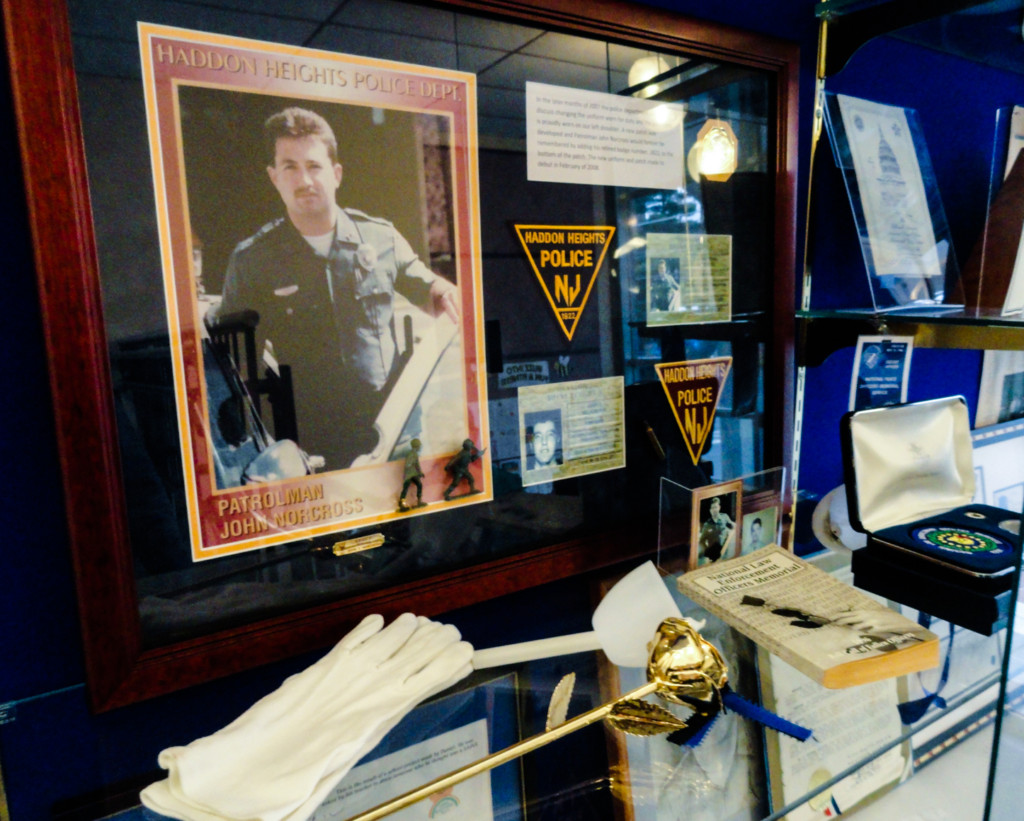
A memorial to fallen officer John Norcross is maintained in the Haddon Heights Municipal Building. Credit: Matt Skoufalos.
“That’s one of the unique things about being a patrol officer in Heights,” Kinkler said; “you’re expected to be a patrolman and be in touch with the community.
“The key thing is making patrol officers understand what their job is: watching basically everything,” he said. “It’s not easy, you have to know what to look for. It’s a constant battle and things do change.”
Even in upholding the law, Kinkler said he has always instructed his officers to educate violators as well as enforce the law.
“We made a point that if we got a parking complaint, we always took it so we could tell people why we do what we do,” he said. “It wasn’t for revenue; our summonses are cheap. Being proactive with traffic in general, enforcement of the law, those are things that keep everybody safe.
“It’s not easy,” he said. “You’re always getting somebody on a bad day. [But] 99 times out of 100, if you talk them through it, they’re okay.”
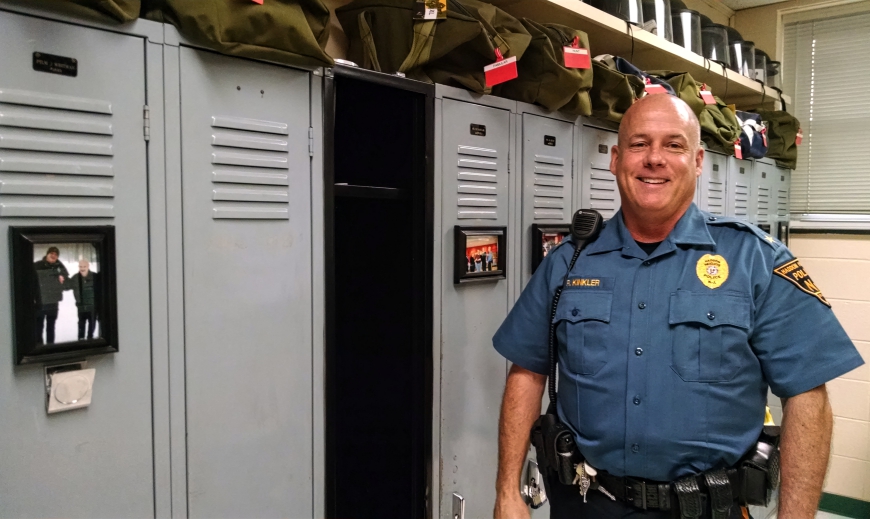
Haddon Heights Police Chief Richard Kinkler stands beside a locker kept empty in memory of the late Ptl. John Norcross. Credit: Matt Skoufalos.
‘A direct connection’
The chief said he’s proudest of the work his department has done building positive relationships with local children, whether touring the station with them to show how the job is done, or talking with them one-on-one about the career track that makes a police officer.
At least some of that has rubbed off on his son, Daniel, who is an officer in the department.
Daniel Kinkler not only will remain “a direct connection” to the department when his father leaves, Richard Kinkler said, but to one of the darkest moments in its history: the April 20, 1995 shooting deaths of HHPD Patrolman John Norcross and Camden County Prosecutor’s Office Investigator John McLaughlin by Haddon Heights resident Leslie Nelson.
His father can trace that moment Daniel Kinkler decided he wanted to become a Haddon Heights Police Officer to a drawing the boy made as a child in memory of Norcross. The picture is still stored in a glass display case in the borough municipal building, along with other artifacts from the case.
“It’s that connection,” Richard Kinkler said. “He’ll be the last guy after Bruce [Koch] retires that was directly affected by the shooting.”
Norcross’s and McLaughlin’s deaths are the only two in the line of duty during Richard Kinkler’s tenure with the department, and they still deeply affect him. The chief has worked to preserve Norcross’ locker as a tribute to his sacrifice, and plans to visit their gravesites as part of his final day on the job.
Even 20 years after that day, Richard Kinkler said the spirit of Haddon Heights still reveals itself in residents rallying around the department.
“It gives you a big hug,” he said.
“I want to thank the residents of Haddon Heights,” the chief said. “They’ve been great to us. There’s a lot of pushback to law enforcement today, but you don’t feel that in Haddon Heights.
“We’ve never been treated better,” he said.
Get more local news that matters. Check out NJ Pen on Facebook and Twitter, or click here to become a supporter.

